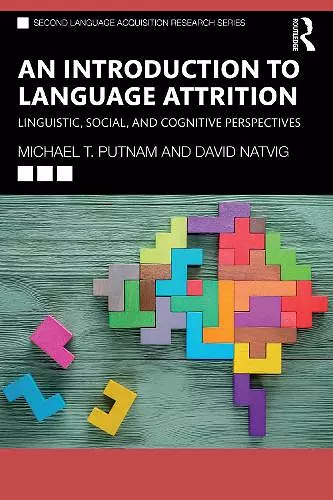An Introduction to Language Attrition
Linguistic, Social, and Cognitive Perspectives
Michael T Putnam author David Natvig author
Format:Paperback
Publisher:Taylor & Francis Ltd
Publishing:20th Jun '25
£36.99
This title is due to be published on 20th June, and will be despatched as soon as possible.

This introductory text brings together diverse perspectives and research streams on language attrition – forgetting or loss of language proficiency that can take place in one’s first or additional language, for different reasons, and at different life stages.
Offering a comprehensive state-of-the-art overview, Michael T. Putnam and David Natvig define key concepts and the contemporary debates in the field, discussing a variety of structural/grammatical, societal, and psychological/cognitive aspects of this phenomenon and their implications for linguistic theory and language learning.
Setting the future research agenda on this subject and with helpful features like discussion questions, this will be an invaluable resource for advanced students and researchers of theoretical & applied linguistics, bilingualism & heritage linguistics, psycholinguistics, sociolinguistics, education, and beyond.
The authors go beyond a simple introduction to the topic of language attrition in providing a brief but exciting overview of the contemporary debate on the nature of language loss in contexts of bilingualism. An appealing feature of this book is that it extends its coverage to attrition at the level of communities as well as the individual mind, giving equal attention to both lexicon and grammar. This lucidly written synthesis serves as an excellent springboard for more advanced study and research.
David Stringer,Indiana University
As is clear from Putnam and Natvig’s comprehensive, nuanced and thought-provoking book, the study of linguistic attrition is inherently complex. Approaching it in a singular, unified way is perhaps, at least presently, unreasonable insofar as ‘attrition’ is a construct that embodies a spectrum of only partially overlapping, yet (potentially) separable processes, mechanisms and manifestations depending on how one applies it. For example, is it representational, processing-based, both? At what stage(s) of attrition’s developmental process is any one study/approach tapping into or even interested in? Is it the same, or to what extent is it the same for all individuals, domains of language and/or types of speakers? How do external factors interact with internal ones to affect the answers to such questions, an important consideration in light of the diversity of individual circumstances under which potential attrition applies? Given all this, what is the best way to theorize about attrition, much less put such ideas to empirical scrutiny? Such questions are presently not entirely answerable, if they ever can be, but Putnam and Natvig makes us think critically about them all, especially how each interacts with the ability to properly address/answer the others. In the end, this important book brings the field closer to a more inclusive, if not exhaustive, approach to studying linguistic attrition while highlighting the many advantages doing so has for multiple theories in the language, psychological and cognitive sciences as well as its practical value for society and individuals.
Jason Rothman,Lancaster University
The study of language attrition has evolved considerably since its beginnings in the 1980s. This text provides an insightful, state-of-the-art overview and discussion of a broad range of topics, from societal, psycho-cognitive and linguistic factors to the various theoretical approaches that have attempted to explain the often-puzzling phenomena – or lack thereof – that can be witnessed in the process of attrition. It will serve as an important point of reference for future research and the ongoing struggle to define what, exactly, language attrition is in the first place.
Monika S. Schmid,University of York
“Putnam and Natvig’s ambitious book introduces key themes within language attrition research through a wide-ranging review that weaves together various complementary perspectives on language attrition. Alongside the book’s comprehensive review of the state of the art, its discussion questions, key term summaries and further reading suggestions ensure that it will serve as a gateway to language attrition research for future cohorts of students of bi/multilingualism and second language acquisition: it is a coherent, accessible introduction, and certainly unlike anything currently available. Furthermore, from the outset Putnam and Natvig make a broader effort to distil unifying research questions from a relatively nascent research field that presently has varied objectives, assumptions and methodologies. While this effort is undoubtedly helpful to readers new to the topic, notably by treating theoretical matters with due rigour throughout the book the authors are moreover able to conceive a unified research program that provides a pathway to move forward the study of language attrition. It is a most welcome and highly valuable contribution to the field.”
Glyn Hicks, Associate Professor in Linguistics, University of Southampton, UK
ISBN: 9781032004983
Dimensions: unknown
Weight: unknown
190 pages